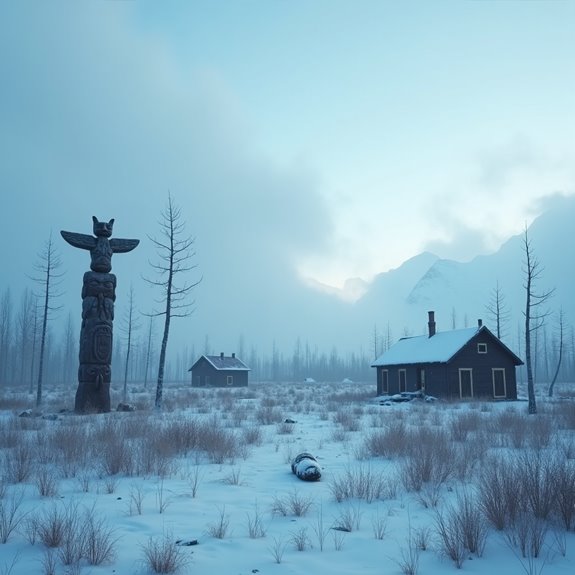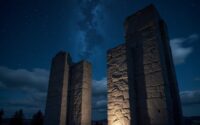What Happened to the Vanished Village of Anjikuni?
In 1930, the Inuit village of Anjikuni mysteriously vanished, leaving behind a haunting echo of its lost inhabitants. Eyewitnesses reported empty homes with meals still simmering on stoves, suggesting a sudden departure. This peculiar phenomenon has sparked numerous theories, from environmental calamities to supernatural forces. Yet, none have provided a definitive answer. What truly happened to those who once called Anjikuni home? The search for understanding continues to intrigue and perplex.
Introduction

The mysterious disappearance of an entire Inuit village in Canada has sparked intrigue and speculation for decades. In 1930, reports emerged that the village of Anjikuni vanished without a trace, leaving behind empty homes and untouched possessions. The last known inhabitants seemingly disappeared overnight, creating an air of mystery that captivated both locals and outsiders. Numerous accounts from travelers and explorers, including one from a fur trader, vividly described the eerie, desolate scene. Some claimed to have found fires still burning in the village, suggesting that the residents had left in haste. Eyewitness testimonies fueled theories ranging from natural disasters to supernatural involvement. The unanswered questions surrounding Anjikuni continue to haunt those fascinated by this baffling tale of loss.
Origins in Inuit Folklore

While stories of disappearing villages might seem far-fetched, Inuit folklore includes various tales of entire communities vanishing under mysterious circumstances. These narratives often reflect deep cultural beliefs and the harsh realities of life in the Arctic. Anjikuni’s legend resonates with Inuit traditions, hinting at a connection to nature and the spiritual world. Some tales suggest that villages disappeared due to malevolent spirits or catastrophic events, leaving only echoes of their existence. The imagery of an abandoned settlement evokes themes of loss and the fragility of human life in a relentless environment. Such stories serve not only as cautionary tales but also as reflections of the Inuit relationship with their surroundings, illustrating the profound impact of landscape on identity and survival.
Notable Cases or Sightings

Inuit folklore’s tales of vanishing communities lay the groundwork for several notable cases and sightings associated with Anjikuni. One of the most famous incidents occurred in 1930 when a group of fur traders reported discovering the eerily abandoned village. They claimed all the inhabitants had vanished without a trace, leaving their homes intact and meals cooking. Additionally, several explorers recounted strange lights and sounds emanating from the area surrounding Anjikuni Lake. Other witnesses described ghostly figures wandering near the frozen landscape, contributing to the mystery. Over the years, various investigations have been launched, yet no conclusive evidence has emerged. Each account adds to the chilling narrative, reinforcing the village’s enigmatic status within local lore and beyond.
Common Theories or Explanations
Several theories attempt to explain the mysterious disappearance of Anjikuni’s inhabitants. Some suggest that the village was subject to a sudden environmental catastrophe, such as a harsh winter or a natural disaster that forced residents to flee. Others propose that the local Indigenous people fell victim to external forces, like disease or attacks from outsiders. Paranormal enthusiasts argue that extraterrestrial involvement accounts for the vanishing, with claims of UFO sightings around the time of the disappearance. Another theory posits that the residents integrated into nearby tribes, choosing to abandon their settlement rather than face modern encroachment. Each explanation provides a unique perspective, but none fully clarifies what truly happened to the vibrant community of Anjikuni. The mystery remains alive in contemporary folklore.
Frequently Asked Questions
What Evidence Supports the Existence of Anjikuni Village?
Evidence supporting the existence of Anjikuni Village includes historical accounts, indigenous oral traditions, and reports from explorers. These sources document interactions with the village, showcasing its cultural significance and location in Canadian folklore.
Are There Archaeological Findings Related to Anjikuni?
Archaeological findings related to Anjikuni include remnants of long-abandoned structures and artifacts, which suggest a once-thriving community. These discoveries intrigue researchers and highlight the village’s significance in understanding the region’s historical landscape and cultures.
How Did Local Authorities Respond to the Disappearances?
Local authorities initiated thorough investigations into the mysterious disappearances, interviewing residents and searching the surrounding areas. They sought explanations and reassurance, but no definitive answers emerged, leaving the community puzzled and concerned about their missing neighbors.
What Impact Did the Myth Have on Nearby Communities?
The myth of the vanished village sparked fear and curiosity among nearby communities. It heightened awareness of local disappearances, led to increased caution, and prompted discussions about safety, ultimately shaping community dynamics and relationships among residents.
Has the Story of Anjikuni Influenced Popular Culture?
The tale of Anjikuni has inspired filmmakers, authors, and artists, who’ve woven its mysterious narrative into various works. Its haunting presence in popular culture keeps audiences captivated, constantly sparking curiosity about unexplained phenomena and lost communities.


